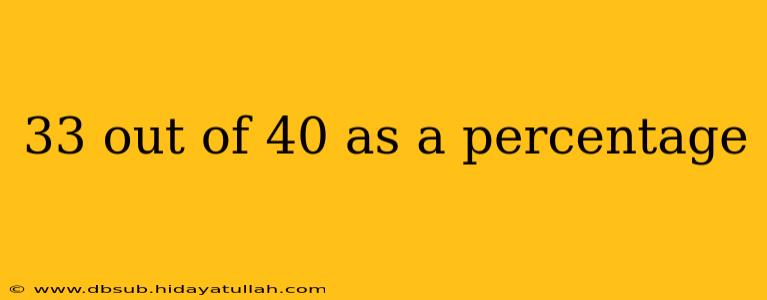33 out of 40 as a Percentage: A Simple Calculation and its Applications
Calculating percentages is a fundamental skill with wide-ranging applications in various fields, from academic grading to financial analysis. This post will clearly explain how to determine the percentage equivalent of 33 out of 40, and explore some real-world scenarios where this calculation proves useful.
Calculating the Percentage
To find the percentage equivalent of 33 out of 40, we use a simple formula:
(Part / Whole) * 100%
In this case:
- Part: 33 (the number we're considering as a portion of the whole)
- Whole: 40 (the total number)
Substituting these values into the formula:
(33 / 40) * 100% = 0.825 * 100% = 82.5%
Therefore, 33 out of 40 is equal to 82.5%.
Practical Applications of Percentage Calculations
Understanding percentage calculations isn't just for math class; it's a crucial skill applicable in many everyday situations:
-
Academic Performance: Imagine a student scoring 33 out of 40 on a test. Knowing that this equates to 82.5% allows for easy comparison with other scores and a clear understanding of their performance. This is crucial for self-assessment and goal setting.
-
Sales and Discounts: Businesses frequently advertise discounts as percentages. If a product originally priced at $40 is discounted by 17.5% (100% - 82.5%), the discount amount is easily calculated: $40 * 0.175 = $7. The final price is then $40 - $7 = $33.
-
Financial Analysis: Percentage calculations are essential in financial reporting and analysis. For example, calculating profit margins, return on investment (ROI), or growth rates often involve expressing figures as percentages. Understanding these percentages provides valuable insights into a company’s financial health.
-
Data Interpretation: Many datasets present data in numerical form, but percentages provide a more accessible and easily understandable way to interpret these figures. Converting raw numbers into percentages simplifies comparisons and highlights trends.
Beyond the Basics: Rounding and Interpretation
While 82.5% is the precise answer, depending on the context, rounding might be appropriate. For instance, in a classroom setting, it might be rounded to 83%. However, maintaining accuracy is crucial in financial reporting. The interpretation of the percentage also depends on the specific application. A score of 82.5% on a test might be considered excellent, while a 82.5% return on investment might be viewed as moderate depending on market conditions and other factors.
In conclusion, calculating percentages is a vital skill with numerous practical applications. Understanding how to accurately calculate and interpret percentages empowers individuals to make informed decisions in various aspects of their lives, from academic pursuits to financial planning. The simple calculation of 33 out of 40 as 82.5% is a prime example of this fundamental skill's widespread utility.
